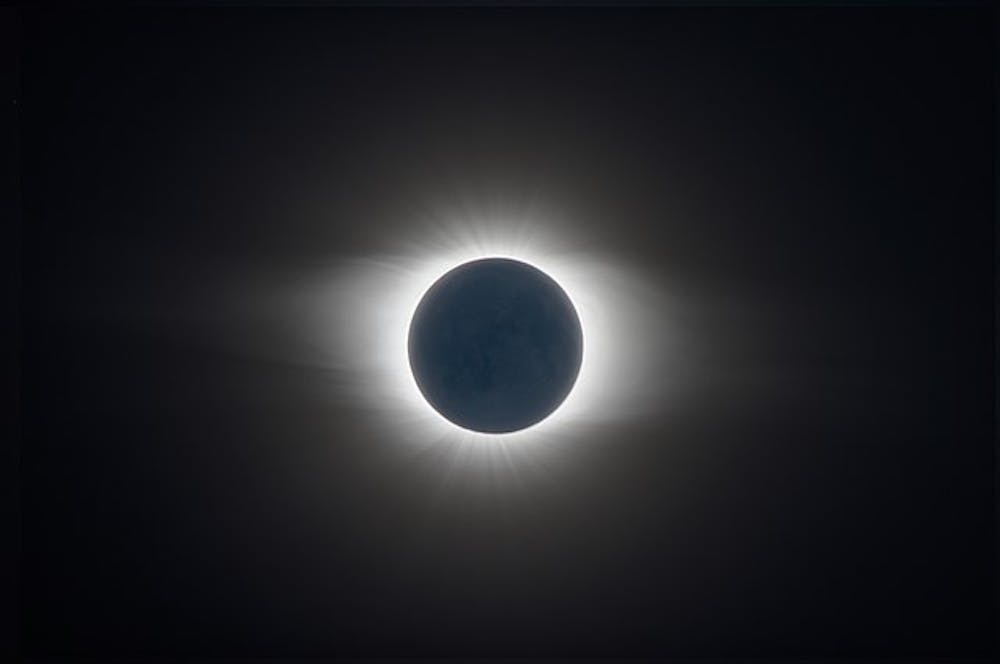On Monday, the UB community and communities across Western New York will direct their eyes to the sky to witness a total solar eclipse — a once-in-a-lifetime event.
Sitting directly in the path of totality — the track that the shadow of the moon traces across the earth — Buffalo will be treated to a first-class view of the celestial event.
In anticipation of Monday’s total eclipse, The Spectrum spoke with five experts to discuss the upcoming phenomenon.
The science of the phenomenon
Before viewing the eclipse, it’s important to understand how and why this rare cosmic event occurs.
Nick DiFrancesco, an assistant teaching professor in the Department of Geology, outlined three factors that influence the formation of a total solar eclipse: the position of the moon, the distance of the moon from Earth and the angle of the moon’s orbit.
“The moon’s distance from the Earth varies all the time because it orbits the Earth in an elliptical path, so that causes the distance between the Earth and the sun to shift occasionally,” DiFrancesco said. “In order for there to be a total solar eclipse, the moon’s distance has to be closer [to the Earth] at the same time that it is in the new moon phase and between the sun and the Earth.”
When all three factors come together to form a total solar eclipse, DiFrancesco described that viewers — weather permitting — will be able to see the corona — the outermost layer of the sun’s atmosphere.
Regardless of the weather, DiFrancesco explained that spectators will still experience environmental effects, including the darkening of the skies, a drop in temperature and changes in animal behavior.
The last time a total solar eclipse occurred in the Western New York region was nearly 100 years ago and the phenomenon will not return to the continental United States until 2044.
Tracy Gregg, a professor and chair of the Department of Geology, noted that total solar eclipses occur on the planet approximately every 18 months, but sometimes those eclipses don’t reach populated regions.
“The width of the [the moon’s] shadow when it hits the Earth is only about 115 miles across and so it is a small path across the land,” Gregg said. “And if it’s over the ocean, it could be places where nobody sees it. It’s not that they’re infrequent. What is infrequent is for the moon’s shadow to hit a part of the planet where there’s lots of people already waiting to watch it.”
Preparations for the total solar eclipse
While having a fun and memorable experience during a total eclipse, it’s also essential to keep yourself safe.
Andrew Reynolds, a clinical associate professor of ophthalmology at the Ross Eye Institute at the Jacobs School of Medicine, emphasized the importance of wearing solar eclipse glasses to view the phenomenon.
Reynolds explained that people who look at the eclipse without proper protection are at risk of developing solar retinopathy — a condition that occurs when the retina is burned from looking at direct sunlight. To avoid eye damage, Reynolds advises people to make sure their glasses comply with the ISO 12312-2 international standard.
“Those are specifically made for viewing the sun for any circumstance,” Reynolds said. “They block over 99.9% of the light, so they are exceedingly dark…And so those are the only way you can directly observe the sun.”
Reynolds added that people can pick up solar eclipse glasses at Erie County public libraries, museums and solar eclipse viewing events. For people who are unable to attain glasses or are reluctant about using the glasses, Reynolds recommended indirect methods, such as making your own solar eclipse pinhole projector.
From approximately 3:18 p.m. to 3:22 p.m., totality — the period in which the moon completely covers the sun — will occur. Reynolds also encouraged observers to set a timer at those times to keep track of when to take off and put back on your glasses.
Before the eclipse, Gregg suggested for students to secure a viewing area in advance for optimal viewing of the eclipse.
“What I recommend people do is over the weekend kind of pre-check their viewing spot and make sure that you’ve got a clean line of sight to the sun,” Gregg said. “And if the spot you thought you were going to use [has] a building in the way, you’ve got time to then find a new spot. You don’t want to wait till the day to sort that out.”
The societal impact of an eclipse
For years, total solar eclipses have been regarded as cultural events that are commemorated by members of society — but that wasn’t always the case.
David Schmid, an associate professor in the Department of English, who specializes in pop culture, reflected on how ancient civilizations reacted to the phenomenon with apprehension.
“We should point out that in many cases, [total solar eclipses] were not really celebrated,” Schmid said. “They were regarded as bad omens or as potentially indicating disaster or a catastrophic event. So, for that reason, in a lot of cultures, the eclipse was seen as a danger that needed to be anticipated and responded to.”
However, Schmid explained that as time progressed and people viewed total eclipses from an astrological perspective, the phenomenon now brings a unifying effect on society.
“We all know that we live in a world that is perhaps today more than ever defined by stress and anxiety and conflict and violence,” Schmid said. “And I think that a phenomenon like an eclipse gives us an opportunity, even if it’s just for a very short period of time, to step away from that context and to focus on not the things that differentiate us, but the things that we have in common.”
As the total eclipse draws closer, the phenomenon is expected to draw in an estimated one million visitors to the city. Schmid added that the eclipse will also bring an economic boost to the Western New York region, pointing to booked and high-priced hotels.
The eclipse in relation to research
As spectators will be watching the phenomenon, scientists will be using it as an opportunity to engage in research.
Beata Csatho, a professor and associate chair in the Department of Geology, will be taking part in the Citizen Continental-America Telescope Eclipse (Citizen CATE) — a project funded by NASA and the National Science Foundation to collect polarized images of the eclipse.
Csatho will be leading one of 35 teams situated in the eclipse’s path. She is joined by four team members from the Geology Department — Ivan Parmuzin, a research specialist, Toni Schenk, a research professor, Travis Nelson, a instructional technician, and Eric Kabe, a PhD student.
“The idea was that if there are many groups making images as the totality is moving, there is an opportunity to put together those observations to a longer time period to study the sun,” Csatho said.
On Monday, the team plans to carry out their research at Lake Erie State Park. To capture polarized images of the eclipse, Csatho and her team were provided a telescope with a proper solar filter, a polarized camera, a laptop and other observational equipment by Citizen CATE.
After each team collects their images and sends them back to Citizen CATE, the images will then be processed and turned into a 60 minute movie.
Csatho hopes the images that the teams collect provide a better understanding of the sun’s corona in terms of the solar wind’s impact on the Earth and how it is heated through magnetic reconnections.
“The main interest is the outer atmosphere, which is called the solar corona,” Csatho said. “And these images will tell us the composition and the structure of the corona because during normal times, the sun is so bright that it is impossible to make this quality of images of the corona.”
Jason Tsoi is an assistant features editor and can be reached at jason.tsoi@ubspectrum.com

Jason Tsoi is an assistant features editor at The Spectrum. He is an English major with a certificate in journalism. During his free time, he can be found listening to music and watching films.





